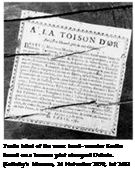|
I |
n the seventeenth century the furniture trade was divided between the ebenistes. the tapissiers (upholsterers) and the mar – chands-merciers. The marchands-merciers included furniture under the same general heading of curiosites’ as shells. Chinese porcelain and scientific instruments. The curiosity’ trade was located on the lie de la Cite near the Palais, and in the rue Saint-Honore, near the Louvre:
Here is a list of dealers who own shops, who buy. sell and trade in pictures. Chinese furniture, porcelain, crystal, shells and other decorative objects and jewellery: M. d’Hostel [Dotel], at the beginning of Quai de la Megisserie; Malaferre and Varenne. quai de I’Horloge: La Fresnaye et Laisgu, rue Saint-Нопогё (near the Fathers at the Oratory]; Quesnel, rue des Bourdonnais; Protais. rue des Assis; Fagnany, quai de I’Ecole (A la Descente de la Samaritaine’); Antheaume, behind the Hotel de Bourgogne; Nancay at the Palais, etc.
These were noted by Abraham du Pradel in the Liure commode des adresses de Paris for 1692. where he also cites other addresses:
M. Dorigny, rue Quinquempoix. M. Laitticr and Mile Lc Brun at the Port of Paris also have fine pieces of porcelain and Chinese ware (i. e. oriental lacquer] (…) M. de Cauroy. rue Briboucher. has a shop for jewellery and English boxes, with pieces of porcelain, pierced terracotta pagodas and Chinese furniture (…) The Sicurs Langlois. father and eldest son. who copy and brilliantly restore Chinese lacquer furniture, are on the Grande-Rue du Faubourg Saint-Antoine near the Hotel de Bel Air (…J They make exceptionally fine cabinets and screens in the Chinese style (…) Sieur Taboureux. who is on the quai de la Megisserie near the Fort I’Evequc. makes very good copies of English coffers and locks.
It may be seen that the curiosity trade specialized in goods from the Far-East and from England. To buy everyday furniture, it was
 necessary to turn directly to the producers. Abraham du Pradel also wrote at the time: ‘Cabinets, bureaux, bookcases and other furniture veneered in walnut, marquetry. el>ony and cedar are made and sold along the Faubourg Saint-Antoine. at the Porte Saint-Victor, rue Neuvc-Saint-M£deric. rue Grenier-Saint-Lazare. rue du Mail, etc.’ Some of the production of the ebenistes was also sold by the upholsterers. a guild that was then very powerful (it was one of the principal suppliers of furniture, as fabrics played such an important role in furnishing in the seventeenth century). The tapissiers – fripiers (upholsterers and second-hand clothes dealers) are mostly grouped under the pillars of les Halles, rue de la Truanderie. Mon – tagne Sainte-Genevieve, Descente du Pont-Marie and the rue du Grenicr-sur-l’Eau.’
necessary to turn directly to the producers. Abraham du Pradel also wrote at the time: ‘Cabinets, bureaux, bookcases and other furniture veneered in walnut, marquetry. el>ony and cedar are made and sold along the Faubourg Saint-Antoine. at the Porte Saint-Victor, rue Neuvc-Saint-M£deric. rue Grenier-Saint-Lazare. rue du Mail, etc.’ Some of the production of the ebenistes was also sold by the upholsterers. a guild that was then very powerful (it was one of the principal suppliers of furniture, as fabrics played such an important role in furnishing in the seventeenth century). The tapissiers – fripiers (upholsterers and second-hand clothes dealers) are mostly grouped under the pillars of les Halles, rue de la Truanderie. Mon – tagne Sainte-Genevieve, Descente du Pont-Marie and the rue du Grenicr-sur-l’Eau.’
The fashion for silver furniture must not be ignored. This was apparently not only commissioned for royal palaces: ‘Furniture in silver is beautifully made by M. Delaunay, silversmith to the King, in front of the Galeries du Louvre.’ Finally, the reputation of the great ebenistes at the end of the century was such that the most important clients went directly to them: ‘M. Cussy (sic) at the Gobelins. Boulle at the Galeries du Louvre. Lefebvre in the rue Saint-Denis at the ‘Chene-Vert’ excel in furniture and other objects with marquetry.’



